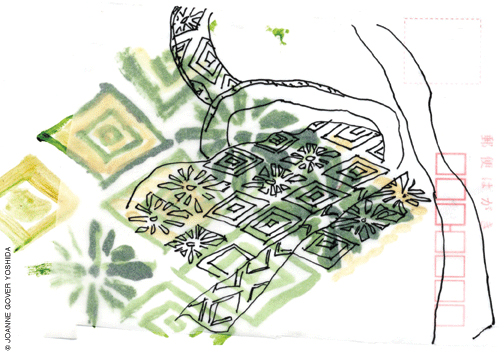
In reeds and rushes, searching for the soul of Japan.
By Joanne Gover Yoshida
Lately I’ve become interested in the diamond patterns on the edge of tatami mats. They’re called heri in Japanese—thin fabrics that line the straw mats traditionally used as floor covering in homes. Traditionally tatami are hand-made by craftsmen who weave a soft reed or rush together with hemp or cotton string. The tatami fringes bring color and pattern to the straw surfaces of the mats. They are a border, and a protective edge.
Those diamonds, to me they are starting to feel like the soul of Japan. Little by little, the mats made of rice straw are becoming things of the past.
Today I rode my bicycle to meet K. at her studio on the other side of the river. She asked if I’d like to be in a group show she was planning for next year. I suggested the heri patterns as a theme. I told her that I’ve only just started the diamond-shaped paintings, but she seemed to like the idea.
On the way home, I stopped in front of what looked like an abandoned shop. The writing on a large, weathered green sign seemed to be calling me. My heartbeat quickened when I realized it was the Japanese character for the word tatami. I peered in to the darkened window, and saw two diamond shapes etched onto the upholstery of an old leather sofa. The cushions were made from pieces of fabric normally used for the edges of tatami. To the left were rolls of tatami edge fabric, glowing like jewels in a dark corner. Thick bands, thin bands, gold diamonds on green, silver interlocking diamonds on blue, floating in patterns that I had never seen.
My eyes came back to the light outside. This time I noticed potted plants in front of the shop, and realized it wasn’t abandoned after all. The pots were styrofoam containers held together by strands of tatami heri. In an overgrown lot adjacent to the shop, more containers of aloe, geraniums, and other blooms were roped in by strings of the faded tatami edging.
An old woman approached and asked what I was doing. I must have looked dubious, stooped next to the plants in my long black coat. I told her I was taking pictures and pointed to the tatami edging that interested me.
She held a cane, her wrinkled hand poised on top. She wore a purple woven sweater, gray polyester patterned pants, and a gray hat. Her eyes peered at me curiously, yet familiarly, from under the hat. As if she knew that she was exactly the person I was looking for, she slid open the shop’s glass door.
We climbed over a turquoise blue broom handle that held the door in its open position. She opened another door to a room that was about two meters below the level we stood on. I peered down and saw, illuminated as if from some divine light, a tatami mat on a table. The ground was bare earth.
I fixed my eyes once more on the rolls of tatami edging, which seemed like treasures that no longer belonged to the age we were in. The stitching, the weave, the diamonds floating in the strips—surely these were already becoming relics from another time.
I sat down with the old woman on the couch and ran my hands along the tatami edge fabric that covered it. This was one I’d never seen. It was a pattern of pine trees, gold on green. Many strips were sewn together to make the surface where we sat. “Jo-to,” the old woman said, and I understood that these were the real thing, of high quality.
We sat quietly, as if we were at a bus stop, looking out at the world of modernity passing by. I couldn’t make out the old woman’s thick dialect, but she seemed to be counting.
I told her I thought that the tatami mats and these heri contained the soul of Japan. “Tamashi,” I practically screamed in her ear to be sure she understood. I didn’t need to say it. It was clear she agreed. It was what had brought us together on that couch to begin with.
I soon realized she was not exactly counting, but rather pointing at one thing after another. “One single person in a car,” she said. “Another one single person in a car … Oh dear, still another.”
She pointed at the storefronts across the street. “All those lights left on for that one room.” She repeated herself with emphasis on the one, as she pointed out office after office whose bright fluorescent lights were glaring above their sole occupants.
I laughed when I finally understood what she was saying. Everything she pointed toward was an instance of people doing things or going places by themselves. Her repetitive litany charted the expanding gulf between one way of life and another. In tatami rooms, people gather together for warmth around a low wood table in winter. Families traditionally sleep together on one futon laid out at night and put away in the morning, to make way for other activities shared during the day. Tatami mats represent a way of living that interweaves nature, family, and community. It is a tactile thing I first experienced when I came to live in Japan 10 years ago. In a tatami room I feel an intimate connection between my bare feet and the straw texture of the mats. New homes and apartment “mansions” in Japan’s cities no longer reflect the same values and connections.
The shopkeeper told me that some days there was no work for her family, who made the tatami mats in a small factory in Hazama. The city storefront is her home, and where they do the finishing touches. I told her my heart felt warm, sitting there, and asked if I could come again sometime. Then we just sat, like two old souls with nothing in the world to do except sit on an old couch, in a dark room, with our hands touching the rich tatami edging as we blinked our eyes into the light of day.
Joanne Gover Yoshida W’82 GAr’86 lives in Oita, Japan.




